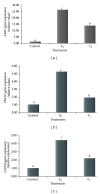Estrogen-responsive genes overlap with triiodothyronine-responsive genes in a breast carcinoma cell line
- PMID: 24587767
- PMCID: PMC3920670
- DOI: 10.1155/2014/969404
Estrogen-responsive genes overlap with triiodothyronine-responsive genes in a breast carcinoma cell line
Abstract
It has been well established that estrogen plays an important role in the progression and treatment of breast cancer. However, the role of triiodothyronine (T₃) remains controversial. We have previously shown its capacity to stimulate the development of positive estrogen receptor breast carcinoma, induce the expression of genes (PR, TGF-alpha) normally stimulated by estradiol (E₂), and suppress genes (TGF-beta) normally inhibited by E₂. Since T₃ regulates growth hormones, metabolism, and differentiation, it is important to verify its action on other genes normally induced by E₂. Therefore, we used DNA microarrays to compare gene expression patterns in MCF-7 breast adenocarcinoma cells treated with E₂ and T₃. Several genes were modulated by both E₂ and T₃ in MCF-7 cells (Student's t-test, P < 0.05). Specifically, we found eight genes that were differentially expressed after treatment with both E₂ and T₃, including amphiregulin, fibulin 1, claudin 6, pericentriolar material 1, premature ovarian failure 1B, factor for adipocyte differentiation-104, sterile alpha motif domain containing 9, and likely ortholog of rat vacuole membrane protein 1 (fold change > 2.0, pFDR < 0.05). We confirmed our microarray results by real-time PCR. Our findings reveal that certain genes in MCF-7 cells can be regulated by both E₂ and T₃.
Figures


Similar articles
-
Estrogen regulation in human breast cancer cells of new downstream gene targets involved in estrogen metabolism, cell proliferation and cell transformation.J Mol Endocrinol. 2004 Apr;32(2):397-414. doi: 10.1677/jme.0.0320397. J Mol Endocrinol. 2004. PMID: 15072547
-
Identification of miR-26 as a key mediator of estrogen stimulated cell proliferation by targeting CHD1, GREB1 and KPNA2.Breast Cancer Res. 2014 Apr 15;16(2):R40. doi: 10.1186/bcr3644. Breast Cancer Res. 2014. PMID: 24735615 Free PMC article.
-
Peroxisome proliferator-activated receptor gamma in human breast carcinoma: a modulator of estrogenic actions.Endocr Relat Cancer. 2006 Mar;13(1):233-50. doi: 10.1677/erc.1.01075. Endocr Relat Cancer. 2006. PMID: 16601291
-
An induction of microRNA, miR-7 through estrogen treatment in breast carcinoma.J Transl Med. 2012 Sep 19;10 Suppl 1(Suppl 1):S2. doi: 10.1186/1479-5876-10-s1-s2. J Transl Med. 2012. PMID: 23227519 Free PMC article.
-
Alternative splicing of the estrogen receptor primary transcript normally occurs in estrogen receptor positive tissues and cell lines.J Steroid Biochem Mol Biol. 1996 Jan;56(1-6 Spec No):99-105. doi: 10.1016/0960-0760(95)00227-8. J Steroid Biochem Mol Biol. 1996. PMID: 8603053 Review.
Cited by
-
A New Perspective on Thyroid Hormones: Crosstalk with Reproductive Hormones in Females.Int J Mol Sci. 2022 Feb 28;23(5):2708. doi: 10.3390/ijms23052708. Int J Mol Sci. 2022. PMID: 35269847 Free PMC article. Review.
-
The Tumor Microenvironment and the Estrogen Loop in Thyroid Cancer.Cancers (Basel). 2023 Apr 25;15(9):2458. doi: 10.3390/cancers15092458. Cancers (Basel). 2023. PMID: 37173925 Free PMC article. Review.
-
Higher order genomic organization and epigenetic control maintain cellular identity and prevent breast cancer.Genes Chromosomes Cancer. 2019 Jul;58(7):484-499. doi: 10.1002/gcc.22731. Epub 2019 Mar 15. Genes Chromosomes Cancer. 2019. PMID: 30873710 Free PMC article. Review.
-
Thyroid function alters during neoadjuvant chemotherapy in breast cancer patients: results from the NEOZOTAC trial (BOOG 2010-01).Breast Cancer Res Treat. 2015 Jan;149(2):461-6. doi: 10.1007/s10549-014-3256-4. Epub 2015 Jan 4. Breast Cancer Res Treat. 2015. PMID: 25556355 Free PMC article. Clinical Trial.
-
Triiodothyronine Promotes Cell Proliferation of Breast Cancer via Modulating miR-204/Amphiregulin.Pathol Oncol Res. 2019 Apr;25(2):653-658. doi: 10.1007/s12253-018-0525-2. Epub 2018 Nov 8. Pathol Oncol Res. 2019. PMID: 30406874
References
-
- Vonderhaar BK, Greco AE. Lobulo-alveolar development of mouse mammary glands is regulated by thyroid hormones. Endocrinology. 1979;104(2):409–418. - PubMed
-
- Gonzalez-Sancho JM, Figueroa A, Lopez-Barahona M, Lopez E, Beug H, Munoz A. Inhibition of proliferation and expression of T1 and cyclin D1 genes by thyroid hormone in mammary epithelial cells. Molecular Carcinogenesis. 2002;34:25–34. - PubMed
-
- Yokoe T, Iino Y, Takei H, et al. Relationship between thyroid-pituitary function and response to therapy in patients with recurrent breast cancer. Anticancer Research. 1996;16(4):2069–2072. - PubMed
Publication types
MeSH terms
Substances
LinkOut - more resources
Full Text Sources
Other Literature Sources
Medical
Research Materials

